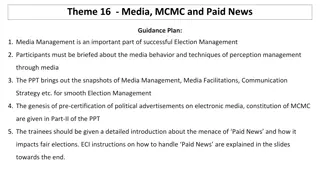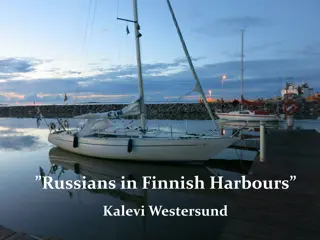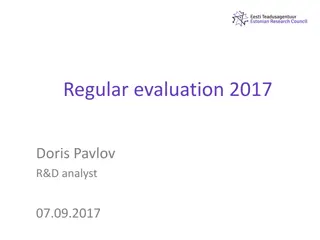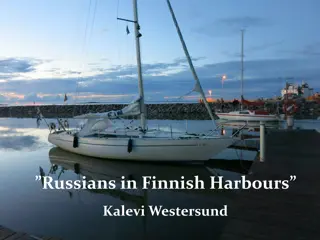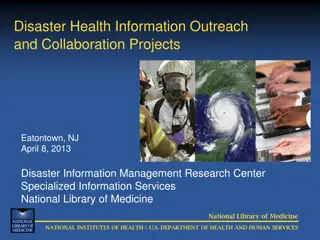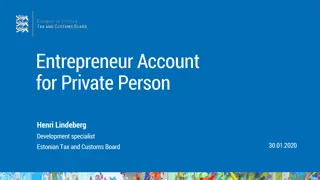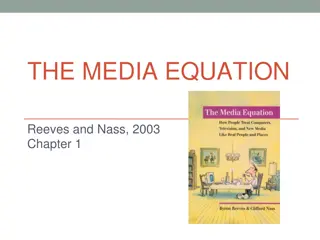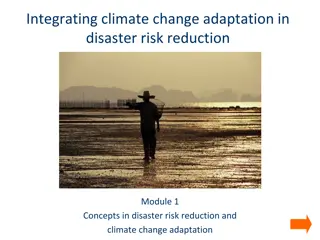Exploring the Construction of MS Estonia Disaster as a Social Icon in News Media
Investigating the role of news media in shaping the MS Estonia disaster as a social icon, this research delves into how the event evolved in the collective memory. Examining coverage from Scandinavian newspapers between 1995 and 2014, the study analyzes themes, transformations, and contributions of media in this construction.
Download Presentation

Please find below an Image/Link to download the presentation.
The content on the website is provided AS IS for your information and personal use only. It may not be sold, licensed, or shared on other websites without obtaining consent from the author. Download presentation by click this link. If you encounter any issues during the download, it is possible that the publisher has removed the file from their server.
E N D
Presentation Transcript
The MS Estonia Disaster: The Construction of a Social Icon in the News Media Finn Frandsen & Winni Johansen Corporate Communication Department of Management Aarhus BSS, Aarhus University
Crises as Social Icons Seeger, Selnow and Ulmer (2003) claim that some crises transform into social icons, around which broader meaning is constructed, maintained, symbolized and conveyed (p. 6) By broader meaning they understand: Events which transform into a narrative Events which inform our understanding of risk, safety and security Events which serve as a lens for interpreting other events Unfortunately, nobody has taken up the challenge of examining how this transformation takes place over time as part of the collective memory of a society.
Aim of this paper The aim of this paper is to investigate how the news media reflect and contribute to the construction of a crisis as a social icon. It presents the findings of a longitudinal case study of how the five largest newspapers in each of the three Scandinavian countries: Denmark, Norway, and Sweden covered the MS Estonia disaster from 1995 to 2014. The cruise ferry MS Estonia sank in the Baltic Sea on September 28, 1994, on its way from Tallinn in Estonia to Stockholm in Sweden. 852 people lost their lives, including more than 500 Swedes. Only 137 survived. More than 700 people have never been identified. The ferry went down in international waters. The wreck has been covered with concrete and is declared a burial place.
The MS Estonia Disaster SLIDE 4
Our research questions RQ1: To what extent have the 15 newspapers produced news stories about the MS Estonia disaster which were published at specific ritualized (commemorative) points in time between 1995 and 2014? Number of articles, type of articles, media coverage or media intervention, activation of news criteria, national differences, etc. RQ2: Have the newspapers focused on the same themes in their coverage and/or intervention, or is there an evolution over time? RQ3: Has the MS Estonia disaster transformed into a social icon, and if yes, how have the news media contributed to this process?
SLIDE 6 Literature review Bos et al. (2005). The long Shadow of Disaster: Memory and Politics in Holland and Sweden. JMED Why are some crises transformed into social icons, whereas other crises just remain crises? It is a political encounter between grass-roots memory and the elite-level, political processing of disasters (pp. 5-6) The politics of crisis management Veil et al. (2011). Memorializing Crisis: The Oklahoma City National Memorial as Renewal Discourse. JACR The Oklahoma City National Memorial Crisis memorials as rhetorical artifacts Renewal discourse: focus on the future, on rebuilding, on opportunities, and on the values and vision of leadership
SLIDE 7 MS Estonia memorials
SLIDE 8 Theoretical framework The historic turn in management and organization studies (see special issue of Academy of Management Review, 2016) History in crisis management and crisis communication Remembrance history: Thepastis defined as everything that happened at a specific point in time Memory is defined as individual and collective representations of parts of the past History is defined as interpretations of remembered parts of the past A social icon: a past event which has become part of history in the present. Inspiration: The concept of collective memory (Halbwachs, 1925, 1950) And the concept of realm of memory (Nora, 1984)
SLIDE 9 Research design Longitudinal case study: 1995-2014 Five most important newspapers in Denmark, Sweden and Norway (based on circulation) Articles collected at five-year intervals - in 1995, 1999, 2004, 2009 and 2014 - five days before and five days after September 28 in the selected years, including both verbal and visual text Crisis journalism and/or mediatization of disasters (Frandsen & Johansen, 2017) Qualitative content analysis: identification of (sub)themes
SLIDE 10 Findings (1) What can we conclude concerning the role of the news media? There is more media coverage than media intervention News criteria are activated. In Denmark, for example, the news media focus on the only Dane who survived (Moren Boje, his son and wife) The newspaper articles are very different: from short to very long; from articles produced by news agencies such as Ritzau to journalistic research A recurrent fact-oriented ritual: the number of people who lost their lives The round birthdays (2004 and 2014) are the most interesting points in time
SLIDE 11 Findings (2) What can we conclude concerning the (sub)themes identified? T(1): Focus on country/countries T(2): Commemorations (official monuments, participants) T(3): Uplift of ship wreck covering with concrete T(4): Causes T(5): Consequences T(6): Actors who react and make demands (e.g., civil associations)) T(7): Stories and testemonies told by survivors (e.g., Morten Boje, the only surviving Dane, publishes a book 10 years after) T(8): Art and culture (e.g., Per Holm s thriller Forlis) T(9): Non relevant themes? V: Press photos, etc.
SLIDE 12 Findings (3) What can we conclude concerning the transformation from crisis (the past) to social icon (history)? The MS Estonia disaster as such is easy to understand, but when it comes to: Causes and consequences: public crisis management We still don t know why MS Estonia sank The cruise ferry sank in international waters 757 people have still not been identified Disagreement between governments and indirect victims, among nation-states, among civil associations There are many voices that communicate A few voices try to construct a broader meaning around the MS Estonia disaster: they all interpret the disaster as a national trauma and compare the disaster with two other traumas (the murder of Olaf Palme in 1986, and the tsunami in 2004).
SLIDE 13 Conclusion Criteria for becoming a social icon? It must be a crisis where causes and consequences are evident Where there is a clear distinction between heroes and villains It must be a crisis that can gather people, bring them together and provide them with an identity and a common collective memory and history
SLIDE 14 Take away messages (1) The past, memory, and history are not one and the same thing (2) Some crisis continue their life far beyond what happened (the crisis event) (3) The news media reflect and contribute to the construction of a social icon (or the history of a crisis) (3) The history of a crisis must be managed in an appropriate way These insights represent new demands for crisis management and crisis communication in private and public organizations.






